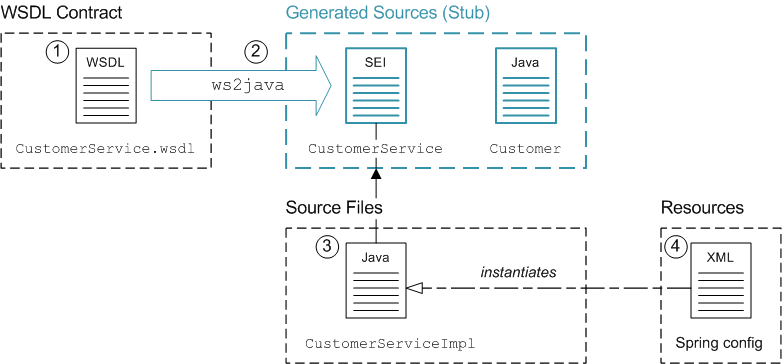Fuse 6 is no longer supported
As of February 2025, Red Hat Fuse 6 is no longer supported. If you are using Fuse 6, please upgrade to Red Hat build of Apache Camel.이 콘텐츠는 선택한 언어로 제공되지 않습니다.
Chapter 35. WSDL-First Service Implementation
35.1. WSDL-First Overview
링크 복사링크가 클립보드에 복사되었습니다!
Overview
링크 복사링크가 클립보드에 복사되었습니다!
If you are familiar with the syntax of WSDL and you want to have ultimate control over the layout and conventions applied to the WSDL contract, you will probably prefer to develop your Web service using the WSDL-first approach. In this approach, you start with the WSDL contract and then use the provided Apache CXF utilities to generate the requisite Java stub files from the WSDL contract.
Demonstration location
링크 복사링크가 클립보드에 복사되었습니다!
The code presented in this chapter is taken from the following demonstration:
cxf-webinars-jboss-fuse-6.2/customer-ws-osgi-bundle
cxf-webinars-jboss-fuse-6.2/customer-ws-osgi-bundle
For details of how to download and install the demonstration code, see Chapter 33, Demonstration Code for Camel/CXF
WSDL contract
링크 복사링크가 클립보드에 복사되었습니다!
The WSDL contract is a platform-neutral and language-neutral description of the Web service interface. In the WSDL-first approach, the WSDL contract is the starting point for implementing the Web service. You can use it to generate Java stub code, which provides the basis for implementing the Web service on the server side.
Service Endpoint Interface (SEI)
링크 복사링크가 클립보드에 복사되었습니다!
The most important piece of the generated stub code is the SEI, which is an ordinary Java interface that represents the Web service interface in the Java language.
The SEI is used in the following ways:
- Base type of the Web service implementation (server side)—you define the Web service by implementing the SEI.
- Proxy type (client side)—on the client side, you use the SEI to invoke operations on the client proxy object.
The CustomerService demonstration
링크 복사링크가 클립보드에 복사되었습니다!
Figure 35.1, “Building a WSDL-First Web Service” shows an overview of the files required to implement and build the
CustomerService Web service using the WSDL-first approach.
Figure 35.1. Building a WSDL-First Web Service
Implementing and building the service
링크 복사링크가 클립보드에 복사되었습니다!
To implement and build the WSDL-first example shown in Figure 35.1, “Building a WSDL-First Web Service”, starting from scratch, you would perform the following steps:
- Create the WSDL contract.
- Generate the Java stub code from the WSDL contract using a WSDL-to-Java converter,
ws2java. This gives you the SEI,CustomerService, and its related classes, such asCustomer. - Write the implementation of the SEI,
CustomerServiceImpl. - Instantiate the Web service endpoint, by adding the appropriate code to a Spring XML file.
